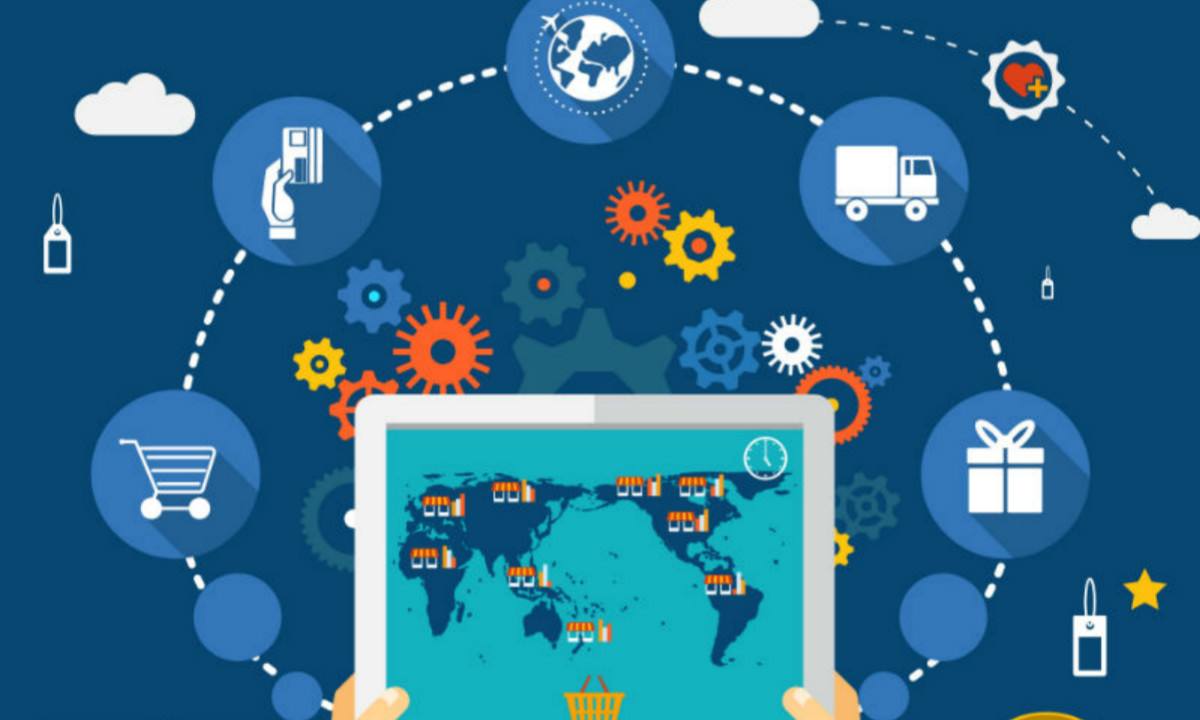I. Overview of China's Cross-Border E-Commerce

1. Development status
Under the promotion of national strategies such as the “Belt and Road” and the Pilot Free Trade Zone, cross-border e-commerce as a new business is booming in China and has become a new driving force for the transformation and upgrading of traditional trading enterprises and the growth of China's foreign trade.
The development of cross-border e-commerce by traditional trading enterprises can effectively promote the upgrading of corporate value chains, promote the upgrading of traditional enterprise structures and the transformation of development methods, and reduce the cost of procurement and sales. According to the monitoring data of the Internet Economics-E-Commerce Research Center, the scale of cross-border e-commerce transactions in China in the first half of 2018 was 4.5 trillion yuan, a year-on-year increase of 25%. Continued blessing of policies has made cross-border e-commerce a new growth point for foreign trade. In the first half of 2018, the scale of cross-border e-commerce transactions was 3.47 trillion yuan, a year-on-year increase of 26%. The scale of imported cross-border e-commerce transactions was 1.03 trillion yuan, a year-on-year increase of 19.4%. The rapid development of export cross-border e-commerce has driven traditional trading companies to leverage the Internet for transformation and upgrading. The development of imported cross-border e-commerce has prompted cross-border e-commerce companies to begin to experiment with offline business development.

2. Cross-border e-commerce business model
The basic models of traditional foreign trade enterprises mainly include export mode, import mode, and re-export mode. With the development of e-commerce and the integration of traditional businesses, China's cross-border e-commerce has developed and formed a multi-border open and multilateral cross-border e-commerce business model. According to the division of import and export flow, it is divided into export-oriented cross-border e-commerce model and imported cross-border e-commerce model. The export-oriented cross-border e-commerce model can be subdivided into e-commerce transactions between enterprises, namely B2B; business-to-person retail e-commerce, ie B2C.
Foreign trade enterprises carry out information display, sales docking and transaction matching on the B2B platform. The main representatives of the B2B platform include Alibaba, China Manufacturing Network, and Dunhuang Network. The transaction is completed online, that is, the B2B+O2O method is adopted, that is, the online matching transaction and the offline settlement method. At present, foreign trade B2B e-commerce is still dominated by information matching and information services. Throughout the entire value chain is the future development trend of cross-border trade. The cross-border e-commerce import model is based on foreign trade B2C and overseas purchasing models. According to the operation mode, it can be divided into two types: cross-border B2B trade service and cross-border network retail.
According to the monitoring data of the Internet Economics-E-Commerce Research Center (100EC.CN), the cross-border e-commerce B2B transactions in China's cross-border e-commerce transactions accounted for 84.6% in the first half of 2018, and the cross-border e-commerce B2C transactions accounted for 15.4. %. From the perspective of transaction size, the cross-border B2B model still dominates. Cross-border B2B involves many services such as supply chain finance, marketing, payment, logistics and warehousing. The industry chain is long. From the perspective of national policies and cross-border e-commerce policies, the B2B model is still an important business model for cross-border e-commerce development in the future. .
3. The favorable policy of cross-border e-commerce in China
In recent years, the state has introduced a series of policies and measures for cross-border e-commerce, which has led to the rapid development of cross-border e-commerce in China.
As the makers of the guiding policies for cross-border e-commerce, the State Council has promulgated favorable documents to support the development of cross-border e-commerce. The cross-border e-commerce comprehensive pilot zone from the pilot to the general benefit fully demonstrates the country's continued positive for the cross-border e-commerce industry. As a key link in the cross-border e-commerce regulatory chain, the General Administration of Customs has introduced a number of initiatives in recent years to ensure the rapid development of cross-border e-commerce. The Ministry of Commerce, the National Development and Reform Commission and other functional ministries have also formulated corresponding policies according to the guidance. The main policy documents are as follows:
4. Development trend of cross-border e-commerce industry in China
As China's cross-border e-commerce transactions continue to expand, cross-border e-commerce will occupy a more important position in import and export trade. As can be seen from Figure 2, the cross-border e-commerce transaction scale increased from 0.8 trillion yuan to 8.06 trillion yuan in 2008-2017. The proportion of total import and export trade increased from 4.4% to 29%. The policy continues to increase the holdings to promote the development of the industry. The cross-border e-commerce of the traditional foreign trade industry will usher in a period of rapid development.

Second, the problems faced by traditional trade enterprises in transforming cross-border e-commerce
1. The status quo of traditional trade enterprises
In recent years, the traditional foreign trade situation has declined and profits have plummeted. Many of the orders and orders of enterprises that are bound by traditional foreign trade channels have fallen sharply, and the profit margin of some products has been continuously affected. In some cases, factories with severe conditions have experienced severe overcapacity or almost production stagnation. According to the "Report on the Survival Status of Foreign Trade Enterprises in 2017", it is pointed out that rising costs and weakening international demand have become the most important factors affecting corporate exports.
2. The significance of transforming cross-border e-commerce by traditional foreign trade enterprises
Traditional international trade companies need to go through multiple circulations to transfer goods to the buyer. The transfer of importers, exporters, wholesalers, and retailers has forced foreign trade companies to lower commodity pricing and thus reduce profits. Cross-border e-commerce eliminates the intermediate links of trade, reduces corporate costs, and increases corporate profits. With the successive introduction of the new policies of the country and the continuous participation of emerging markets, the space for cross-border e-commerce will be further expanded, and the transformation of traditional foreign trade enterprises will usher in new business opportunities.
3. Advantages and limitations of traditional trade enterprises transforming cross-border e-commerce platforms
The advantage of traditional foreign trade enterprises lies in their comprehensive understanding of the company's own products, markets and foreign consumers, which is conducive to the accumulation of profound professional knowledge and industry information. In the market opening, foreign trade companies are all produced according to international orders. These orders always follow the trend of the international market environment. Therefore, traditional foreign trade enterprises are out of the market for which products are out of stock and which products are profitable.
However, the transformation of B2B cross-border e-commerce by traditional foreign trade enterprises also has limitations, mainly in the following points:
Platform construction problem: At present, China's B2B cross-border e-commerce business is still immature, and there is no platform with a certain scale, which is still in the exploration stage.
One way is to directly interface with cross-border e-commerce platforms to achieve supply transactions: this is the simplest and most direct way for traditional trading companies to enter cross-border e-commerce. Different from traditional factory customers, cross-border e-commerce sellers have different characteristics and customer requirements in all aspects of product quality, packaging, procurement flexibility, product optimization, and response speed. To truly cooperate with high-quality sellers and establish stable long-term cooperative relationships with sellers, it is necessary to make appropriate adjustments in terms of product development, flexible production, inventory modules, etc. according to the requirements of cross-border retailers, so as to maximize the satisfaction of partners. Demand. However, by cutting into cross-border e-commerce in this way, it is still difficult for factories to change the fate of the role of earning processing fees.
Another way is to build a self-owned brand from a cross-border e-commerce platform. This has both advantages and disadvantages. The advantage is self-flexibility, without the limitations of large-platform operating rules; the disadvantage is that certain investment and technical consumption are required at the beginning of the project. More consideration in cross-border B2B business is to make an attempt, often just adding a new department, and not really putting it at the height of the strategic choice of the entire factory development.
Cross-border logistics development lag: Cross-border e-commerce logistics operation process includes: First, the seller delivers the goods to the customs of the exporting country through domestic logistics; second, after the export customs office has completed the container, it will be transported by air or sea to the overseas airport. The port; third, to do customs clearance, and then sent to the overseas logistics warehouse; Fourth, the use of foreign logistics for delivery. The development of cross-border e-commerce logistics is lagging behind. There are problems such as long delivery time, difficulty in tracking the whole process of parcel logistics information, difficulty in guaranteeing after-sales service, and complicated customs clearance procedures.

Cross-border logistics involves customs clearance, inspection and quarantine, shipping, air transportation, overseas warehouses, e-commerce platform, overseas marketing, warehousing, customs clearance, tax rebate, etc., for different target customers and market environment, it is necessary to adopt different e-commerce operation strategies, and Corresponding to the need to deploy efficient cross-border e-commerce logistics system and a comprehensive cross-border e-commerce logistics infrastructure. At present, China's cross-border e-commerce logistics infrastructure is still not perfect, and there are some unreasonable places in the design of logistics system. There are still gaps in the application of information technology. Cross-border e-commerce logistics still cannot be stored in overseas warehousing, transportation, distribution, and return. To meet the growing demand for cross-border e-commerce, the lack of effective coordination between cross-border e-commerce logistics and cross-border e-commerce, the level of development of the two does not match, to a certain extent restrict the rapid development of cross-border e-commerce. Therefore, cross-border e-commerce logistics still has a huge upside space to integrate the best resources through efficient processing of inventory, warehousing, order processing, logistics and other links to provide comprehensive supply chain solutions for cross-border e-commerce.
There are problems with the payment system: With the rapid development of cross-e-commerce, more and more traditional trading companies pay more attention to the integrity of e-commerce transactions. B2B online payment is the most important part of e-commerce development, and it is the most basic tool for the platform to obtain capital flow. However, in actual use and promotion, B2B payment is not satisfactory. In B2C payment, both third-party payment companies and banks can perfectly realize online payment, such as Taobao and Jingdong. However, for B2B online payment, the interface between the public banks is not uniform, the number of supported banks is limited, and there are optimization problems between the banks, and many incompatibilities occur.
The payment operation process is more complicated. B2B payments generally involve a larger amount, so the security level of the payment design is much higher than B2C and C2C payments. Before the enterprise realizes online payment, it must open the “business payment” service to the bank, and need to increase the security U shield (digital certificate). However, the bank supported by B2B online payment is limited, and the bank that the enterprise opens is not necessarily the target bank supported by the enterprise. In the list, companies often do not want to spend too much time to pay online.
In terms of capital transfer efficiency, B2B involves a large value of goods and a large number. If the merchant's collection cycle is the same as B2C and C2C, it takes a long time from order to receipt, inspection, and payment. For some SMEs, more cash flow is needed. Under normal circumstances, capital recovery is not accepted, so they are more willing to accept the traditional payment method, the first payment or the pre-received transaction mode.
Cross-border e-commerce talent training: According to the "China Cross-border Electric Merchants Standards", cross-border electric businessmen must have the following characteristics: familiar with international trade rules and cross-border platform operations; high demand for foreign language skills; demand for computer technology talents A large amount; pay attention to the practical ability of cross-border electric traders. Cross-border e-commerce practitioners need to have a comprehensive grasp of international trade, international logistics, cross-border marketing, e-commerce and other related knowledge. According to the national culture, background and consumption habits of different consumers, it is necessary to have a good knowledge reserve and language communication ability.
However, there are not many composite people with international trade knowledge and e-commerce skills in China, and it is difficult to meet the needs of foreign trade enterprises to carry out international trade under the B2B cross-border e-commerce environment. The courses offered by many schools cannot be closely linked to employment. The demand for teaching and business practice is out of touch, and it is difficult to cultivate compound talents that solve practical problems and have practical ability. Lack of practical training has led to a lack of practical knowledge in website operations, website promotion, and image processing. In an era of deepening internationalization, China needs to cultivate a group of complex e-commerce management talents with an international vision and adapt to the global market.

Third, the traditional trade enterprises to transform B2B cross-border e-commerce countermeasures
1. Construction of cross-border e-commerce platform
Traditional trade enterprises combined with overseas marketing networks can integrate the advantages of traditional foreign trade companies with cross-border B2B platforms by integrating upstream and downstream resources such as banking, insurance, and commodity inspection. The platform construction finance, customs clearance, tax rebate, foreign exchange, sales, logistics, after-sales service and other modules provide manufacturers with one-stop foreign trade services. Such as logistics and transportation, export agents, global marketing and promotion. The following is a cross-border B2B platform development plan:
First, consolidate the basic operations of e-commerce. Continuously improve and optimize the platform functions to provide users with a more convenient experience; enrich the platform commodity categories; for professional operations, foster professional operation teams, increase external promotion; improve overseas layout. Reasonably lay out overseas institutions, strengthen the control and service capabilities of global resources and markets, and provide customers with purchasing and sales services. Second, improve platform business traffic. Broaden the demand channel, carry out differentiated and hierarchical management of platform members, provide differentiated services, and tap customer needs. Improve platform visibility and impact and capture effective procurement needs. Improve the efficiency of sourcing.
Once again, stimulate the e-commerce platform to create vitality. First, provide professional services. Provide suppliers with professional services for e-commerce operations, including multi-lingual translation services, productization of products, value of products, suppliers can purchase services according to their own needs, or classify members of the platform, and operate services of different content as members. Differentiated rights are provided.
Second, innovative business operations. Promote self-operated business, continue to explore the core varieties of self-operated enterprises, form a business model with cross-border e-commerce characteristics; innovate business models, give play to the policy advantages of cross-border e-commerce comprehensive pilot zones, try to cross-border retail areas, and have channels Cooperate with competitive partners to develop a cross-border consumer goods business model combining import bonded and retail.
Third, create value-added services. To build international logistics, insurance, customs clearance and other service support sectors, including online logistics commissioning, customs single window docking and so on. Explore cross-border e-commerce financial products and services, conduct international factoring business, and generate revenue through value-added services.
2. Strengthen logistics management and improve logistics system
The relationship between logistics and e-commerce platform is a kind of mutual condition and mutual power. E-commerce has a competent logistics system. The two can promote each other and accelerate development together; on the contrary, they may also restrict each other. The perfect logistics module can provide users with a better and more convenient user experience, increase user stickiness, effectively support the development of trading business, and promote efficient coordination and sharing of the supply chain of all related parties. Complete logistics information can provide convenient services for transaction authenticity, promote platform information flow, business flow, logistics, and capital flow to ensure the transparency, sunshine and traceability of platform transactions, and further deepen the comprehensive service of the platform and create supply. The ecosystem has laid the foundation. Establish a complete logistics module to provide logistics services to related parties, integrate logistics resources through platform and provide high-quality services to platform users, and use information technology to help platform customers reduce their operating costs.
In the relevant links of logistics and distribution, such as bonded areas, customs clearance, quarantine and other links to develop optimization measures, improve management practices, and promote the international development of domestic logistics express delivery enterprises. Introduce service quality standards suitable for cross-border logistics companies. Improve the cross-border logistics system and integrate business resources for the “small batch, multi-batch, fast and efficient” transportation mode of cross-border e-commerce logistics. Improve information systems and vigorously develop overseas warehouses. Through advanced information systems, enterprises can analyze consumer purchase behaviors and consumption habits, improve the efficiency of overseas warehouse cargo allocation, reduce inventory, and enhance customer shopping experience. Through data exchange and integration of internal and external supply chain information, we ensure seamless communication between cross-border e-commerce enterprises and logistics enterprises, ensuring that cross-border logistics can respond quickly, thus improving the cross-border logistics development lags behind the cross-border e-commerce innovation and development.
3. Strengthen the cultivation of cross-border electricity merchants
Through the various training modes such as universities, enterprises, social training, and international professional certification, the training of cross-border e-commerce composite professionals will be strengthened. Cross-border e-commerce composite talents should have relevant knowledge and skills in international trade, e-commerce and international logistics, and have good foreign language ability. The e-commerce platform, universities and training institutions will jointly build a public platform for e-commerce online learning. With the Internet as the carrier, relying on the resources of universities and training institutions, build an e-commerce online learning public platform, and carry out e-commerce talent training and training. Increase the government support for e-commerce practitioners to participate in vocational qualification training, and help the e-commerce practitioners to obtain vocational training opportunities through the government's purchase of services. Intensify cooperation with international cross-border e-commerce enterprises, introduce advanced international knowledge systems, build an international training platform for electric traders, and cultivate e-commerce talents suitable for China's national conditions.
4. Improve the payment system and control the payment risk
Traditional trading companies can use the Internet financial thinking to consider from the perspective of big data, through the B2B platform transactions, as far as possible to achieve information flow, capital flow, logistics, business integration, establish a customer risk control system, provide a line for buyers and sellers The financing loan service solves the problem of capital turnover for platform users, adds other value-added services, and guides customers to conduct transactions through the B2B platform. Uniformly standardize B2B online payment banking and third-party interfaces to optimize browser compatibility and improve user experience. From the bank side, the payment process is simplified, and the digital certificate of the business payment service of the enterprise is integrated into the original online payment U shield to improve the operation efficiency of the user. Reduce the time of corporate capital transfer, sign the network cooperation agreement through B2B online payment function, pay in stages, pay part of the deposit to the manufacturer, use it for raw material stocking production, classify the customer's transaction flow, and realize the quality customer. On behalf of the purchase of goods, the funding period is shortened, thus solving the seller's funding problems.

Fourth, the conclusion
In summary, the transformation of cross-border e-commerce by traditional trading enterprises needs to find a correct position, promote comprehensive talent training, optimize the construction of cross-border industrial platforms, improve the payment system, strictly control the payment risk, and continuously innovate the logistics model, thereby promoting the enterprise in the international Long-term development under the new trade situation.
【 Go Back 】 | 【 Print 】 | 【 Close this window 】